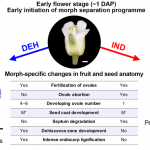Plant Science Research Weekly: May 28, 2021
Review. Under siege: virus control in plant meristems and progeny
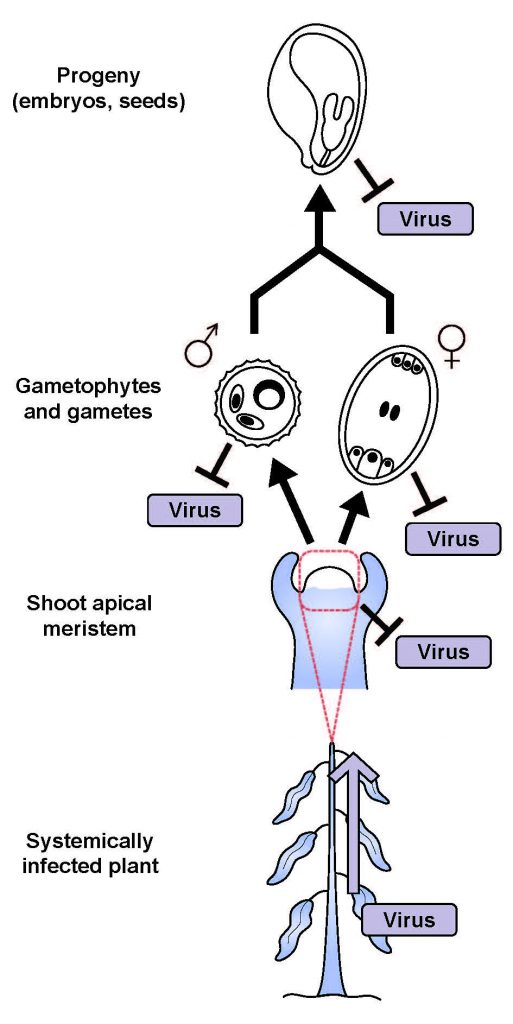 Perhaps, when our lives have been turned upside down by a human pathogenic virus, it’s easy to overlook the fact that plants too suffer from viral infections; but of course, they do. (And of course, famously, viruses were first discovered in plants). Although it is difficult to cure a plant of a virus infection, horticulturalists have long known that the plant meristem is often virus-free (leading to the common method of meristem culture to produce virus-free plants) and often the seeds are too. Here, Bradamante et al. review the mechanisms through which meristems and ultimately seeds exclude viruses. These include blocking the movement of viruses through plasmodesmata, the tiny gateways that connect plant cells, and RNA interference machinery that prevents viruses from replicating. However, sometimes viruses overcome these defense strategies and invade meristematic and eventually reproductive tissues. The authors discuss strategies through which the plant defends against viral infection and movement, how some viruses overcome those defenses, and how in some cases plants can recover from meristem invasion. The authors also suggest additional avenues of research, observing, “The real and potential perils of virus seed transmission in staple crop species and the commercial relevance of maintaining virus-free plant material should challenge investigators to better understand the meristematic and transgenerational antiviral barriers deployed by plants.” (Summary by Mary Williams @PlantTeaching) Plant Cell 10.1093/plcell/koab140
Perhaps, when our lives have been turned upside down by a human pathogenic virus, it’s easy to overlook the fact that plants too suffer from viral infections; but of course, they do. (And of course, famously, viruses were first discovered in plants). Although it is difficult to cure a plant of a virus infection, horticulturalists have long known that the plant meristem is often virus-free (leading to the common method of meristem culture to produce virus-free plants) and often the seeds are too. Here, Bradamante et al. review the mechanisms through which meristems and ultimately seeds exclude viruses. These include blocking the movement of viruses through plasmodesmata, the tiny gateways that connect plant cells, and RNA interference machinery that prevents viruses from replicating. However, sometimes viruses overcome these defense strategies and invade meristematic and eventually reproductive tissues. The authors discuss strategies through which the plant defends against viral infection and movement, how some viruses overcome those defenses, and how in some cases plants can recover from meristem invasion. The authors also suggest additional avenues of research, observing, “The real and potential perils of virus seed transmission in staple crop species and the commercial relevance of maintaining virus-free plant material should challenge investigators to better understand the meristematic and transgenerational antiviral barriers deployed by plants.” (Summary by Mary Williams @PlantTeaching) Plant Cell 10.1093/plcell/koab140
Review: Functional packaging of seeds
 In this review, Huss and Gierlinger describe the different anatomical features that shape sclerenchyma function in hard seed encapsulations. Hard encapsulations are classified as static (non-deforming at the macroscopic level) or responsive (deforming in response to environmental changes), depending on whether they deform during their life cycle. The properties of these structures depend on sclerenchyma composition and arrangement. Responsive encapsulations are constituted by fibers and are found in fruits that open in response to wetting, drying or heating. These fruits have predetermined breaking points, where tissues and cell walls have reduced thickness or lignification gaps. Their stiffness is shaped by the orientation of cellulose microfibrils, with larger angles between fibrils reducing stiffness. Contrastingly, static encapsulations are found in both fruits and seeds, and their composition is highly variable. For example, the coconut endocarp is formed by fibers and sclereids arranged in different directions, a pattern that provides high toughness. Contrastingly, walnut shells are formed by 3D-puzzled sclereids with varying degrees of lignification. The implications of these different structures in plant evolution and ecology are discussed. (Summary by Carlos A. Ordóñez-Parra @caordonezparra) New Phytol. 10.1111/nph.17299
In this review, Huss and Gierlinger describe the different anatomical features that shape sclerenchyma function in hard seed encapsulations. Hard encapsulations are classified as static (non-deforming at the macroscopic level) or responsive (deforming in response to environmental changes), depending on whether they deform during their life cycle. The properties of these structures depend on sclerenchyma composition and arrangement. Responsive encapsulations are constituted by fibers and are found in fruits that open in response to wetting, drying or heating. These fruits have predetermined breaking points, where tissues and cell walls have reduced thickness or lignification gaps. Their stiffness is shaped by the orientation of cellulose microfibrils, with larger angles between fibrils reducing stiffness. Contrastingly, static encapsulations are found in both fruits and seeds, and their composition is highly variable. For example, the coconut endocarp is formed by fibers and sclereids arranged in different directions, a pattern that provides high toughness. Contrastingly, walnut shells are formed by 3D-puzzled sclereids with varying degrees of lignification. The implications of these different structures in plant evolution and ecology are discussed. (Summary by Carlos A. Ordóñez-Parra @caordonezparra) New Phytol. 10.1111/nph.17299
Molecular insights into the complex mechanics of plant epidermal cell walls
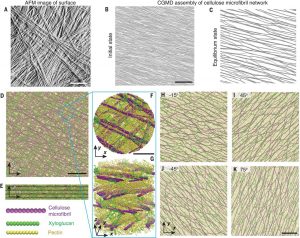 Primary plant cell walls are made up of three types of polysaccharides: cellulose, hemicellulose, and pectin, the orientations and interactions of which provide the cell wall with its properties. Here, Zhang et al. examined the outer wall of onion epidermal cells through atomic-force microscopy, stress-strain functional assays, and mesoscale coarse-grained molecular dynamics (CGMD). The models they developed closely match the structures, dynamics and functions of the real cell walls. For example, the models highlight the importance of the cellulose microfibrils, which carry most of the stress. The model allowed the authors to explore the effects of altering proportions of and interactions between different polymers. These studies provide new and unexpected understandings of cell wall properties. Furthermore, as described by the authors, “The ingenious microstructural and architectural design of plant epidermal cell walls suggests ways to engineer strong and extensible fibrous materials with multifunctional applications.” (Summary by Mary Williams @PlantTeaching) Science 10.1126/science.abf2824
Primary plant cell walls are made up of three types of polysaccharides: cellulose, hemicellulose, and pectin, the orientations and interactions of which provide the cell wall with its properties. Here, Zhang et al. examined the outer wall of onion epidermal cells through atomic-force microscopy, stress-strain functional assays, and mesoscale coarse-grained molecular dynamics (CGMD). The models they developed closely match the structures, dynamics and functions of the real cell walls. For example, the models highlight the importance of the cellulose microfibrils, which carry most of the stress. The model allowed the authors to explore the effects of altering proportions of and interactions between different polymers. These studies provide new and unexpected understandings of cell wall properties. Furthermore, as described by the authors, “The ingenious microstructural and architectural design of plant epidermal cell walls suggests ways to engineer strong and extensible fibrous materials with multifunctional applications.” (Summary by Mary Williams @PlantTeaching) Science 10.1126/science.abf2824
Stretched by Stress: PIEZO1 is a mechanosensitive ion channel in Arabidopsis
 Plants are constantly susceptible to mechanical stress and they have evolved intracellular signaling mechanisms to adapt to mechanical stimulation. Whilst it is known that ion channels activate signaling pathways in response to mechanical stress, only few of these mechanosensitive channels have been identified in plants. Here, Mousavi and colleagues characterized PIEZO1 (PZO1), a member of a family of ion channels that are well known in transducing mechanical signals in animals, as a mechanosensitive channel in Arabidopsis thaliana. The authors found the protein expression to be abundant in the roots, especially around the root cap that experiences high mechanical pressure when growing into the substratum. Roots of seedlings mutated in PZO1 were unable to grow inside solid agar medium. Using electrophysiological and calcium (Ca2+) imaging experiments, the authors showed that PZO1 is a non-selective cation channel that mediates currents in response to mechanical stimulus and is required for mechanical stress-induced Ca2+ signaling. This study is thus an important contribution in understanding mechanosensing in plants and the conserved function of PZO channel family in plants and animals. (Summary by Pavithran Narayanan @pavi_narayanan). PNAS. 10.1073/pnas.2102188118
Plants are constantly susceptible to mechanical stress and they have evolved intracellular signaling mechanisms to adapt to mechanical stimulation. Whilst it is known that ion channels activate signaling pathways in response to mechanical stress, only few of these mechanosensitive channels have been identified in plants. Here, Mousavi and colleagues characterized PIEZO1 (PZO1), a member of a family of ion channels that are well known in transducing mechanical signals in animals, as a mechanosensitive channel in Arabidopsis thaliana. The authors found the protein expression to be abundant in the roots, especially around the root cap that experiences high mechanical pressure when growing into the substratum. Roots of seedlings mutated in PZO1 were unable to grow inside solid agar medium. Using electrophysiological and calcium (Ca2+) imaging experiments, the authors showed that PZO1 is a non-selective cation channel that mediates currents in response to mechanical stimulus and is required for mechanical stress-induced Ca2+ signaling. This study is thus an important contribution in understanding mechanosensing in plants and the conserved function of PZO channel family in plants and animals. (Summary by Pavithran Narayanan @pavi_narayanan). PNAS. 10.1073/pnas.2102188118
Give and Take: Lipid exchanges drove the evolution of mutualism during plant terrestrialization
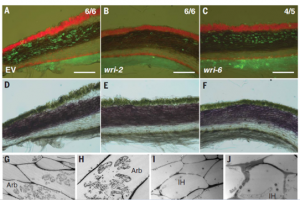 Plants form symbiotic associations with a variety of microbial partners, among which arbuscular mycorrhizal fungi (AMF) are prominent. AMF are known to enrich plants with a host of vital nutrients including the essential macronutrient phosphorus. While the finer details of plant-AMF association are known in angiosperms, those in bryophytes remain less well resolved. Rich and co-workers have now found transfer of lipids from the bryophyte Marchantia paleacea to the AMF Rhizphagus irregularis as a vital aspect of the evolution of this symbiosis. RNA sequencing of AMF-inoculated host plant samples indicated a role for lipid biosynthesis, which is conserved across land plants that share symbiosis with AMF. The authors manipulated the host lipid synthesis machinery to produce a unique lipid molecule that was detected in both the host as well as the fungal partner, in agreement with the lipid transfer hypothesis. Finally, the authors identified the lone member of WRINKLED (WRI) family of transcription factors in M. paleacea as necessary for this lipid biosynthesis and transfer, mutation in which rendered the AMF unable to form arbuscules inside the plant cells. Together, these results throw light on the hitherto unknown origins of the evolution of plant-AMF mutualism and their possible roles in terrestrialization of land plants. (Summary by Pavithran Narayanan @pavi_narayanan). Science. 10.1126/science.abg0929
Plants form symbiotic associations with a variety of microbial partners, among which arbuscular mycorrhizal fungi (AMF) are prominent. AMF are known to enrich plants with a host of vital nutrients including the essential macronutrient phosphorus. While the finer details of plant-AMF association are known in angiosperms, those in bryophytes remain less well resolved. Rich and co-workers have now found transfer of lipids from the bryophyte Marchantia paleacea to the AMF Rhizphagus irregularis as a vital aspect of the evolution of this symbiosis. RNA sequencing of AMF-inoculated host plant samples indicated a role for lipid biosynthesis, which is conserved across land plants that share symbiosis with AMF. The authors manipulated the host lipid synthesis machinery to produce a unique lipid molecule that was detected in both the host as well as the fungal partner, in agreement with the lipid transfer hypothesis. Finally, the authors identified the lone member of WRINKLED (WRI) family of transcription factors in M. paleacea as necessary for this lipid biosynthesis and transfer, mutation in which rendered the AMF unable to form arbuscules inside the plant cells. Together, these results throw light on the hitherto unknown origins of the evolution of plant-AMF mutualism and their possible roles in terrestrialization of land plants. (Summary by Pavithran Narayanan @pavi_narayanan). Science. 10.1126/science.abg0929
A spatiotemporal molecular switch governs plant asymmetric cell division
 In multicellular organisms, stem cells produce various cell types through asymmetric cell division (ACD), which is achieved is through polarization of cell-fate determinant proteins in the ACD progenitor cells. In Arabidopsis stomatal development, an ACD progenitor cell, the meristemoid mother cell (MMC), produces daughter cells with different cell-fates: a meristemoid and a stomatal lineage ground cell (SLGC). MMCs emerge from protodermal cells (PrC) through the activity of the SPEECHLESS (SPCH) transcription factor, which promotes expression of the scaffolding protein BREAKING OF ASYMMETRY IN THE STOMATAL LINEAGE (BASL). BASL polarizes at the cell membrane and establishes cellular asymmetry together with other scaffolding proteins to assemble the polarity complex. Differences in the composition of the polarity complex in MMCs vs SLGCs trigger either cell-division or fate specification/differentiation, respectively, however the mechanism hasn’t been delineated. A recent paper by Guo and colleagues identified the phosphatase BSL1 as part of the polarity complex through its interaction with BASL. The authors show that BSL1 polarizes to the cell membrane in a BASL-dependent manner at the onset of mitosis and promotes repartitioning of the BIN2 kinase to the nucleus through its phosphatase activity. Parallel to this, BSL1 activates the YODA MAPK signaling pathway which leads to SPCH degradation and inhibition of cell division in the SLGC. This work demonstrates that BSL1 polarization at the entry of MMC cell division acts as a spatiotemporal molecular switch that triggers essential changes in the composition of the polarity complex and thus fine-tunes MMC ACD. (Summary by Jesus Leon @jesussaur) Nature Plants 10.1038/s41477-021-00906-0
In multicellular organisms, stem cells produce various cell types through asymmetric cell division (ACD), which is achieved is through polarization of cell-fate determinant proteins in the ACD progenitor cells. In Arabidopsis stomatal development, an ACD progenitor cell, the meristemoid mother cell (MMC), produces daughter cells with different cell-fates: a meristemoid and a stomatal lineage ground cell (SLGC). MMCs emerge from protodermal cells (PrC) through the activity of the SPEECHLESS (SPCH) transcription factor, which promotes expression of the scaffolding protein BREAKING OF ASYMMETRY IN THE STOMATAL LINEAGE (BASL). BASL polarizes at the cell membrane and establishes cellular asymmetry together with other scaffolding proteins to assemble the polarity complex. Differences in the composition of the polarity complex in MMCs vs SLGCs trigger either cell-division or fate specification/differentiation, respectively, however the mechanism hasn’t been delineated. A recent paper by Guo and colleagues identified the phosphatase BSL1 as part of the polarity complex through its interaction with BASL. The authors show that BSL1 polarizes to the cell membrane in a BASL-dependent manner at the onset of mitosis and promotes repartitioning of the BIN2 kinase to the nucleus through its phosphatase activity. Parallel to this, BSL1 activates the YODA MAPK signaling pathway which leads to SPCH degradation and inhibition of cell division in the SLGC. This work demonstrates that BSL1 polarization at the entry of MMC cell division acts as a spatiotemporal molecular switch that triggers essential changes in the composition of the polarity complex and thus fine-tunes MMC ACD. (Summary by Jesus Leon @jesussaur) Nature Plants 10.1038/s41477-021-00906-0
A TOTally new pathway regulating thermomorphogenesis
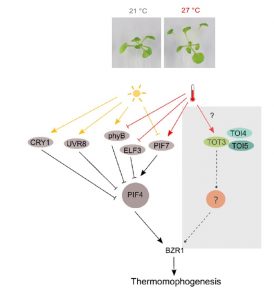 Increase in ambient temperature often causes remarkable changes in the shape and organization of plant body, including elongation of hypocotyl and petioles, early flowering, and reduction in stomatal index, collectively known as thermomorphogenesis. Virtually all the molecular pathways that are known to regulate thermomorphogenesis act through the light signaling factor PHYTOCHROME INTERACTING FACTOR4 (PIF4). PIF4 levels are in turn controlled by the photoreceptor Phytochrome B (phyB), which acts as a thermosensor. Overall, warm temperature signaling works in a highly intertwined manner with light signaling. In a new study, Vu et al. unveil the existence of a parallel pathway in temperature signaling that works independently from the conventional phyB-PIF4 pathway. Analyzing the changes induced by warm temperature in the phosphoproteomes of Arabidopsis, soybean and wheat, the authors identified a conserved membrane-localized MAP4 Kinase protein, which they named as TOT3 (TARGET OF TEMPERATURE 3). The loss of function of TOT3 in Arabidopsis and wheat hampered the ability to elongate the hypocotyl and leaf sheath, respectively, in response to warm temperature. Through an array of evidence, the authors vindicate the light signaling-independent action of TOT3. It works in association with other MAP4Ks through physical interaction and phosphorylation, and finally impinges on brassinosteroid signaling via BZR1 to promote thermomorphogenesis. Although further mechanistic details remain to be uncovered, this study clearly registers a novel molecular axis in temperature signaling. (Summary by Yadukrishnan Premachandran @yadukrishprem) Nature Comms. 10.1038/s41467-021-23112-0
Increase in ambient temperature often causes remarkable changes in the shape and organization of plant body, including elongation of hypocotyl and petioles, early flowering, and reduction in stomatal index, collectively known as thermomorphogenesis. Virtually all the molecular pathways that are known to regulate thermomorphogenesis act through the light signaling factor PHYTOCHROME INTERACTING FACTOR4 (PIF4). PIF4 levels are in turn controlled by the photoreceptor Phytochrome B (phyB), which acts as a thermosensor. Overall, warm temperature signaling works in a highly intertwined manner with light signaling. In a new study, Vu et al. unveil the existence of a parallel pathway in temperature signaling that works independently from the conventional phyB-PIF4 pathway. Analyzing the changes induced by warm temperature in the phosphoproteomes of Arabidopsis, soybean and wheat, the authors identified a conserved membrane-localized MAP4 Kinase protein, which they named as TOT3 (TARGET OF TEMPERATURE 3). The loss of function of TOT3 in Arabidopsis and wheat hampered the ability to elongate the hypocotyl and leaf sheath, respectively, in response to warm temperature. Through an array of evidence, the authors vindicate the light signaling-independent action of TOT3. It works in association with other MAP4Ks through physical interaction and phosphorylation, and finally impinges on brassinosteroid signaling via BZR1 to promote thermomorphogenesis. Although further mechanistic details remain to be uncovered, this study clearly registers a novel molecular axis in temperature signaling. (Summary by Yadukrishnan Premachandran @yadukrishprem) Nature Comms. 10.1038/s41467-021-23112-0
A tale of two morphs: seed coat differentiation in the dimorphic diaspore model Aethionema arabicum (Brassicaceae)
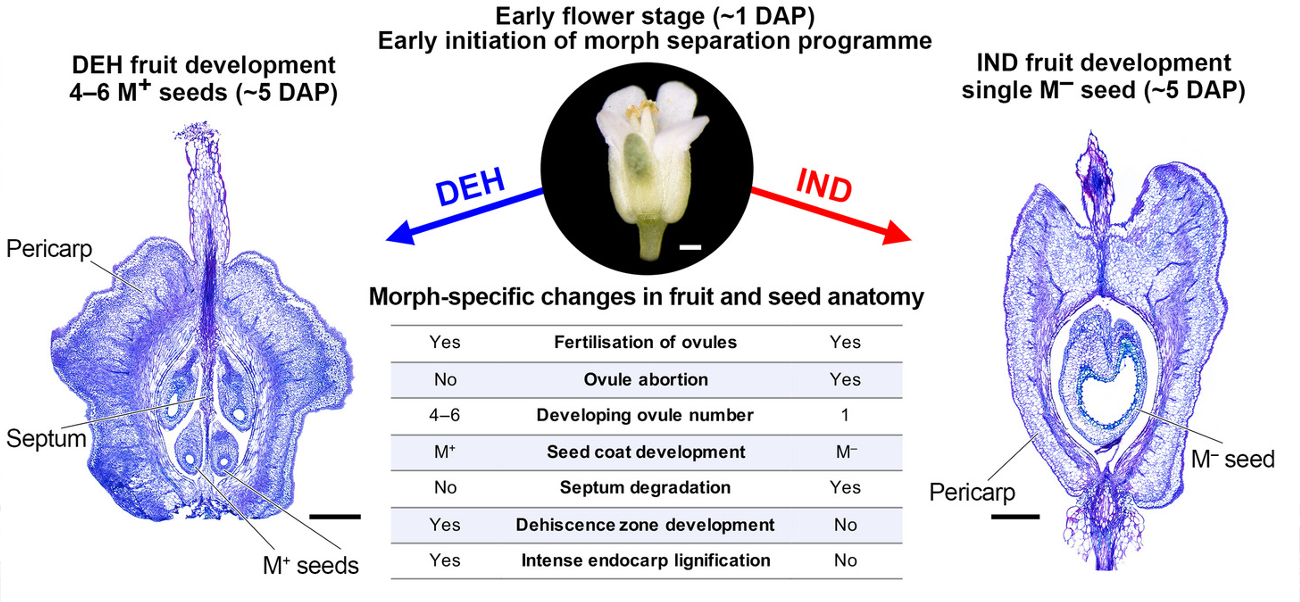 While most plants have a single fruit and seed form, several species produce two or more distinct fruit and seed types, although the mechanisms behind this phenomenon remain unknown. Here, Arshad and colleagues assess the differences in the internal morphology and transcriptomic profile throughout development of the two diaspore morphs of Aethionema arabicum. One morph is a dehiscent fruit with multiple mucilage-producing seeds (DEH), while the other is an indehiscent fruit with a single seed that does not produce mucilage (IND). Comparative image analysis showed that flowers that will give rise to each morph appear identical before pollination. However, soon after pollination their morphology starts to diverge. Accordingly, the transcriptome of flower buds is quite similar between morphs, but it becomes increasingly different after pollination. Consequently, differences in the developmental program of each morph arise in the earliest stages of fruit development. Various transcription factors have distinct expression profiles between morphs, including potential genes related to ovule abortion, seed coat differentiation and mucilage production. This paper provides a starting point to understand the mechanisms behind producing fruits and seeds of different morphology in a single plant. (Summary by Carlos A. Ordóñez-Parra @caordonezparra) Plant J. 10.1111/tpj.15283
While most plants have a single fruit and seed form, several species produce two or more distinct fruit and seed types, although the mechanisms behind this phenomenon remain unknown. Here, Arshad and colleagues assess the differences in the internal morphology and transcriptomic profile throughout development of the two diaspore morphs of Aethionema arabicum. One morph is a dehiscent fruit with multiple mucilage-producing seeds (DEH), while the other is an indehiscent fruit with a single seed that does not produce mucilage (IND). Comparative image analysis showed that flowers that will give rise to each morph appear identical before pollination. However, soon after pollination their morphology starts to diverge. Accordingly, the transcriptome of flower buds is quite similar between morphs, but it becomes increasingly different after pollination. Consequently, differences in the developmental program of each morph arise in the earliest stages of fruit development. Various transcription factors have distinct expression profiles between morphs, including potential genes related to ovule abortion, seed coat differentiation and mucilage production. This paper provides a starting point to understand the mechanisms behind producing fruits and seeds of different morphology in a single plant. (Summary by Carlos A. Ordóñez-Parra @caordonezparra) Plant J. 10.1111/tpj.15283



